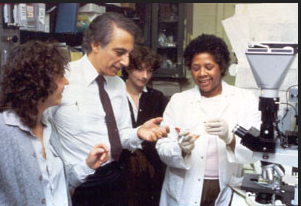 Robert Gallo, co-discoverer of the HIV virus, in the early 1980s among (from left to right) Sandra Eva, Sandra Colombini, and Ersell Richardson Robert Gallo, co-discoverer of the HIV virus, in the early 1980s among (from left to right) Sandra Eva, Sandra Colombini, and Ersell Richardson |
A report released Nov. 27, by the Centers for Disease Control, shows that, nationally, the proportion of young people diagnosed with HIV has risen. In 2010, youth aged 13- 24 made up more than one quarter of all new HIV infections.
More than half of those newly diagnosed infections – 57 percent—were among Black youth. And almost 60 percent of the young people diagnosed with HIV had no idea that they were infected. The risk of contracting HIV is highest for young Black men, Hispanic men, and men who have sexual contact with men. But Black girls and women also have a higher risk.
In Oregon, the proportion of youth diagnosed with HIV has also risen. But it remains below the national figure at 15 percent of all new cases. Another 15 percent of new diagnoses were for people aged 25-29. Racial disparities in HIV infections are lower in Oregon than across the United States. But Black Oregonians are still about 3 times as likely to become infected as Whites.
The 2011 statistics show that Black people account for 5 percent of new HIV diagnoses in Oregon, down from 5.9 percent during 2006-2010. Hispanics account for 15 percent of new HIV cases, making them twice as likely as White Oregonians to become infected.
Kim Toevs, a public health expert with Multnomah County's HIV and STD programs, says it's a myth that Black Americans engage in more risky behaviors than other groups. In fact, Black youth are less likely to use IV drugs, less likely to engage in risky sexual behaviors, have about the same number of sex partners, and are just as likely to use condoms.
The problem for Black Americans, Toevs says, is that the infection rate is already higher in the Black community, so mathematically, for people who choose partners within their own community, the risk is higher.
"It's not about sex," she says. "African Americans' behaviors are as safe, or safer, than the general population. The reasons for the disparities have to do with historical inequities, poverty and lack of access to healthcare.
"There's no easy fix. We can't just throw a whole lot of free healthcare money at the problem and expect it to go away. We're going to have to address a whole range of inequities."
High incarceration rates among Black men, for example, destabilize families, and lead to partner changes. And the more partners you have, the higher your risk of coming into contact with the HIV virus.
HIV is passed through sexual contact and IV drug use, and the risks remain far higher for men who have sex with men –because that community already has a higher rate of HIV infections. However, all African Americans, and particularly Black women, are more likely than other groups to become infected through heterosexual sex.
Nationally, the CDC says 9 -12 percent of new HIV cases occur because of IV drug use. In Oregon, 7 percent of HIV cases identified in 2011 were attributed to IV drug use. Portland's harm reduction approach and its needle exchange programs have lowered transmission rates among IV drug users, Toevs says.
"On the West Coast generally, HIV is lower in injection drug using population, than it is on the East Coast."
Toevs says Everyone Should Get an HIV Test at Least Once: Call the Oregon HIV/STD Hotline at 800-777-2437 or go to the Cascade AIDS Project's website to find testing sites. You can take a test in your own home. Tests similar to home pregnancy tests are now available in drug stores and online.


















































































































































































































































































































